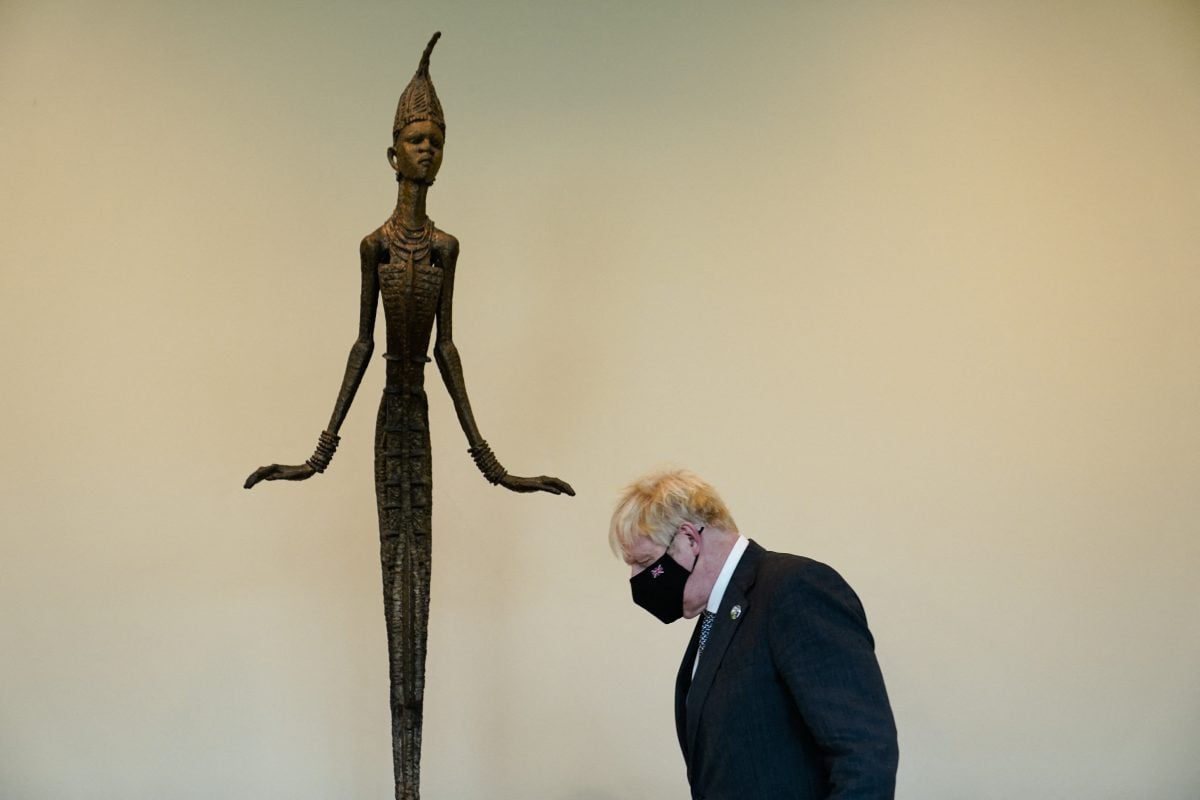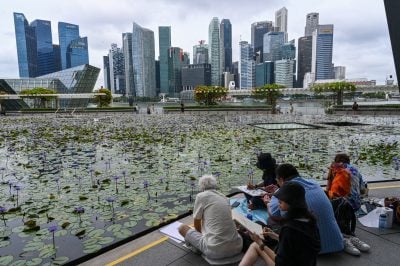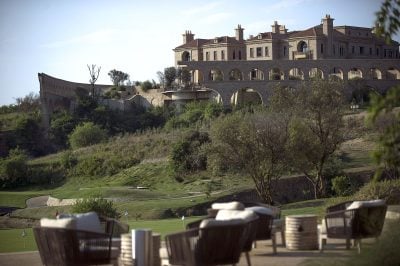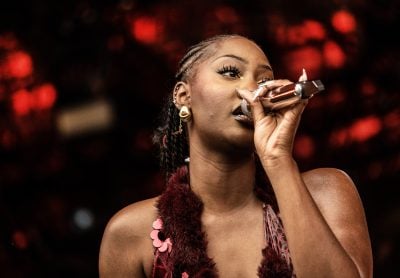Since his death 30 years ago, the Nigerian painter and sculptor Ben Enwonwu has been widely hailed as one of Africa’s greatest artists.
Enwonwu’s paintings and sculptures are displayed in galleries and public venues around the world, but two of his artworks were recently discovered in the UK, hiding in plain sight – one had even been used as a doorstop. The finds have shone a spotlight onto Enwonwu’s life and work once more.
When a guest brought an unknown item to be appraised on the BBC TV series Antiques Roadshow, little did he know that it was a rare Ben Enwonwu sculpture. He had bought it several years earlier at a car boot sale for £50 ($60): its value today is estimated at up to £15,000 ($18,300).
The base of the stone sculpture bears a plaque reading “Ben Enwonwu–Igbo Sculpture” with the signature of the Zwemmer Gallery in London. It was the stamp of the gallery that convinced the experts of the sculpture’s authenticity. They estimated that it dates from the 1970s, when Enwonwu was at the height of his fame – though the gallery closed in 1968.
Several days earlier, a previously-unknown Enwonwu watercolour poster from 1942 had been discovered in the UK’s National Archives. Yams depicts the transportation of yams along a river, and was commissioned by the UK’s Ministry of Information during the Second World War as part of its efforts to increase food production and encourage self-sufficiency in West Africa.
The poster has since been verified by the director of modern and contemporary African art at the auction house Bonhams and by Enwonwu’s biographer, neither of whom were previously aware of its existence.
This isn’t the first time one of Enwonwu’s works has been discovered by chance, either. In 2017, his painting Tutu, which had been classed as missing since 1975, was discovered in the attic of a flat in London, and sold at Bonham’s for £1.2m ($1.4m), against an estimate of £300,000.
A distinguished career
The life of the artist later called “the most influential African artist of the 20th century” by the Guardian was not an easy path to success. Enwonwu was born in Onitsha, Nigeria, in 1917 during colonial rule, to a cloth merchant mother and an engineer and sculptor father. Enwonwu inherited his father’s tools after his death and began carving in the style of Igbo sculpture.
Enwonwu studied fine art in Nigeria, and the success of his first solo exhibition in Lagos in 1944 won him a scholarship to the Slade School of Fine Art in London, where he graduated with a first-class degree. After working at several schools in Nigeria, his reputation rose throughout the 1940s and 1950s. He was appointed as art adviser to the Nigerian colonial government from 1948.
In 1955, to mark Nigeria’s looming independence, the Nigerian National Museum commissioned Enwonwu to create Anyanwu, a bronze statue representing the Igbo mythological figure and earth goddess Ani, which still sits outside the museum today.
Enwonwu came to global attention in 1957, when he created an over life-sized bronze sculpture of Queen Elizabeth II, commissioned by the Queen on her visit to Nigeria the previous year. In doing so, Enwonwu became the first African artist to produce an official portrait of a European monarch. The Queen sat for Enwonwu in London, and the statue was unveiled later that year. Enwonwu’s biographer Sylvester Ogbechie said in his 2008 work Ben Enwonwu: The Making of an African Modernist that the statue “amalgamates the distinctive features of Queen Elizabeth with the serene expression of Enwonwu’s Head of a Yoruba Girl sculpture”.
Enwonwu’s son, Oliver Enwonwu, who is also an artist, commented on his father’s decision on how to portray the Queen during an interview with CNN in 2022.
“Some of the rave reviews that the sculpture received said that the artist depicted the queen through his African eyes – the work had African features, which was characteristic of his style,” he said.
Queen Elizabeth II subsequently commissioned Enwonwu to create a bust of her eldest son, then Prince Charles, now King Charles III.
Ben Enwonwu, Master of the British Empire
However, Enwonwu’s association with the British monarchy led to some criticism by those who believed it to be a betrayal of Nigerian nationalism. Enwonwu was awarded an MBE (Member of the Most Excellent Order of the British Empire) for his sculpture of the Queen while Nigeria was on the brink of gaining independence.
In an essay in African Studies Quarterly in 1998 Nkiru Nzegwu, now distinguished professor for research at State University of New York at Binghamton, accused Enwonwu of “seeking validation from colonial masters” in creating the sculpture. Yet Enwonwu was a staunch supporter of Nigerian independence, and gave a speech in Paris in 1956 stating that: “I know that when a country is suppressed by another politically, the native traditions of the art of the suppressed begin to die out. Then the artists also begin to lose the values of their own artistic idiom. Art, under this situation, is doomed.”
As an artist and an individual, Enwonwu navigated a complex identity, struggling to unify his success in the British art world with his African identity, particularly after experiencing racism during his time living in London. He acknowledged the difficulties of embracing modernist art techniques while rejecting the colonial views that dismissed African art as primitive and tribal, and celebrated Western innovation.
In an interview with the BBC in 1958, he stated: “I will not accept an inferior position in the art world. Nor have my art called ‘African’ because I have not correctly and properly given expression to my reality.”
Throughout his life Enwonwu gave speeches in support of black art and artists, and created several series of paintings and sculptures celebrating Africa and blackness, such as his Africa Dances series, crafted throughout the 1960s.
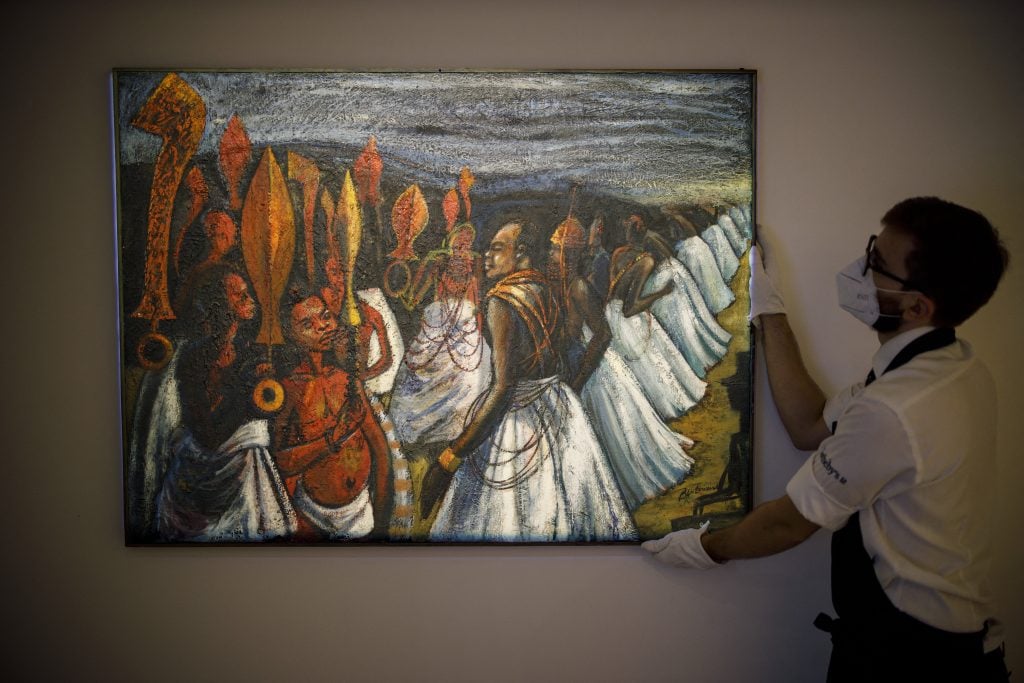
An image of reconciliation
In the years after the ruinous Biafran War, Enwonwu’s works heavily celebrated Igbo culture. In 1971 he painted Christine, a portrait of an American hairstylist who lived in Lagos with her British husband, which sold in 2019 for £1.1m. Enwonwu created his most famous work, Tutu, in 1973: it was considered a reconciliation symbol between the government and Biafran separatists. The series of three portraits which have been dubbed the African Mona Lisa, depict the Ifẹ princess Adetutu Ademiluyi. All three had been missing since 1975, but the second version was rediscovered in 2017. Speaking to the Guardian, Nigerian-British novelist Ben Okri described the find as “the most significant discovery in contemporary African art in over 50 years.” Enwonwu died in 1994 at the age of 76, after a lifetime of bridging the African and Western art worlds. Fusing European artistic techniques with African and Igbo culture, Enwonwu’s work challenged Western preconceptions of African art, and asserted the identity of post-colonial Nigeria on the global stage.
His work has since been displayed in prominent locations worldwide – in the picture above, then-British Prime Minister Boris Johnson passes Enwonwu’s Anyanwu at the United Nations headquarters in New York.
Enwonwu has been regarded as the defining voice of modernist art in Africa, and has gone on to inspire many artists since, including Nigerian-British artist Yinka Shonibare, who, in a 2021 interview with New Internationalist stated that admiring Enwonwu’s sculptures was one of his earliest experiences of art and cultural heritage. Enwonwu’s legacy endures today as a testament to the power of art to transcend boundaries, and define identity in the face of a changing world.
Want to continue reading? Subscribe today.
You've read all your free articles for this month! Subscribe now to enjoy full access to our content.
Digital Monthly
£8.00 / month
Receive full unlimited access to our articles, opinions, podcasts and more.
Digital Yearly
£70.00 / year
Our best value offer - save £26 and gain access to all of our digital content for an entire year!

 Sign in with Google
Sign in with Google 